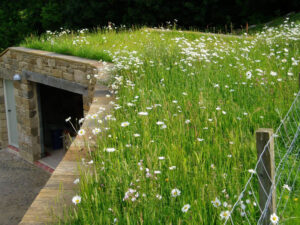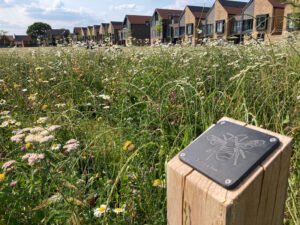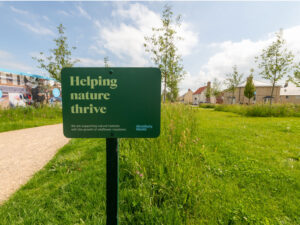The amount of biodiversity gain is measured using a standardised metric, which takes into account the type, quality, and size of habitats. BNG is achieved by enhancing existing habitat, creating new habitats, or a combination of the both.
Biodiversity Net Gain (BNG) mandates developers to prioritise habitat enhancement and habitat creation onsite, within the development boundary, followed by registered offsite BNG.
Why is Biodiversity Net Gain (BNG) important?
BNG pushes development towards a future where nature thrives alongside progress, benefitting ecosystems and even our own well-being.
Biodiversity also plays an important role in regulating the climate. By protecting and enhancing biodiversity, BNG can help to make ecosystems more resilient to the impacts of climate change such as flooding and droughts.
How does BNG affect me?
BNG affects all of us. UK residents will benefit from the much needed positive impact on biodiversity after years of net loss. The advantages include more areas of natural beauty, improved mental health, better air quality, and much more.
For those responsible for advising and implementing BNG legislation, there are numerous considerations. We have detailed these further below and have dedicated pages for Landscape Contractors, Ecologists & Conservationists, Developers and Landscape Architects. Within these pages, you will find valuable insights, and we offer a free downloadable, easy-to-follow guide with key information and tips.
Are you searching for BNG positive products that are easy to install & maintain, with a support network behind you?
> Find out more
As an Ecologist or Conservationist specifying ways to achieve positive BNG for your clients can be challenging.
> Find out more
Are you looking for a partner to help you deliver the most effective and comprehensive BNG solutions?
> Find out more
Landscape Architecture, where ecological requirements, aesthetics and management challenges must co-exist.
> Find out more
Did you know…
How can wildflowers solve your BNG requirements?
Wildflowers offer a fantastic solution to achieving BNG requirements. With the UK having lost 97% of its wildflower meadows since the 1930s, restoring these vibrant, beautiful habitats is a crucial step toward achieving biodiversity net gain.



Key benefits of selecting wildflowers include:
Cost effective – It is a low cost solution compared to many other alternatives. Established wildflower spaces require minimal maintenance, with just one mandatory cut annually in September. This ease of maintenance also applies to green roofs.
Biodiversity – Wildflower mixes create a highly biodiverse habitat, continually increasing biodiversity over the years. As the original creators of Wildflower Turf over 20 years ago, we have a proven track record of product longevity, providing confidence in achieving the 30 year audit required by BNG legislation.
Natural Beauty – Wildflower spaces are among the most visually pleasing options, offering ever-changing beauty and a variety of annual products. They attract a rich habitat of insects and animals.
Like for like – Our laboratory can develop bespoke seed mixes using native wildflowers specific to the area. This ensures a matched environment appropriate to the location, promoting local biodiversity.
Frequently Asked Questions about BNG
Biodiversity Net Gain (BNG) is a way of creating and improving natural habitats. BNG ensures new developments have a positive impact on biodiversity of at least a 10% increase compared to the biodiversity prior to development; it must be maintained for a minimum period of 30 years.
A developer built a housing development where a meadow used to be. The developer must ensure they make up for the impact on that habitat, as well as deliver a 10% increase in biodiversity.
BNG is measured using the biodiversity metric. The metric should be used by an expert, typically an ecologist. The metric measures changes in habitats. It compares the site prior to and post development. The comparison includes 4 key sections; habitat size, condition, distinctiveness, and location.
BNG ensures developments/developers have a positive impact (‘net gain’) on biodiversity, aiming to leave the natural environment in a measurably better state than it was beforehand, by achieving a net gain of at least 10%.
A minimum of 10% biodiversity net gain must be made for at least 30 years, either onsite, offsite or by buying statutory credits as a last resort (this has to be approved).
In short, small sites until April 2024, developments below the threshold, householder applications, self-build and custom build applications, biodiversity gain sites, and high speed rail transport networks are all exempt. To gain more in depth knowledge visit https://www.gov.uk/guidance/biodiversity-net-gain-exempt-developments
Small sites are exempt from BNG until April 2024. Developments that are below the threshold of not impacting any priority habitats, e.g. they disrupt less than 25 square metres of regular habitats, or 5 metres of linear habitats such as hedgerows, are exempt from BNG.
Additionally, householder applications are exempt (e.g. home extensions) and self build and custom build applications (they cannot be any larger than 0.5 hectares or no more than 9 dwellings). A biodiversity gain site and, finally, any developments on high speed rail transport networks are also exempt from BNG.
The legislation that is being implemented from January 2024 is only specific to England, however, Wales does have a similar system in place aimed at improving biodiversity, but does not have a set minimum % figure or a mandatory 30 year period.
Classification of the type, distinctiveness, condition, connectivity and strategic significance of habitats by a professional prior to and post development.
BNG credits have a range of prices dependent on the habitat that is being disturbed, they are categorised into low, medium and high habitat distinctiveness (HD), as well as broad and specific habitat type and, finally, tier. Credits start at a cost of £42,000.